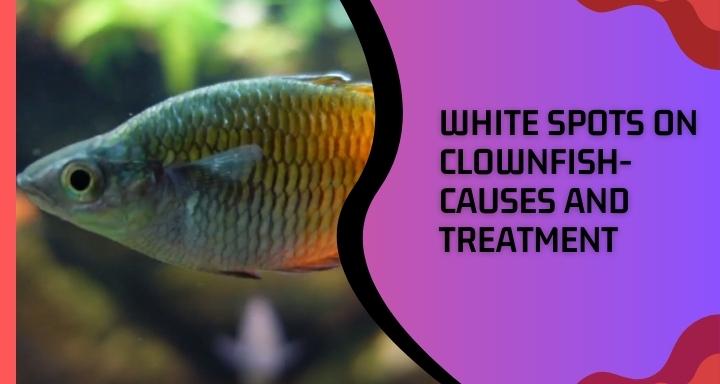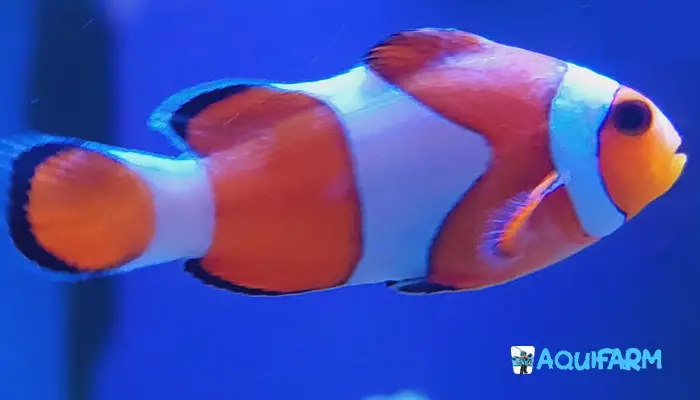
Treating white spots on clownfish is always supposed to be a disaster to me. The main causes of clownfish diseases or white dots on clownfish are clownfish ich, poor nutrition, illness, velvet disease, lymphocystis disease, brooklynella disease, and physical damage.
Some symptoms may inform you about the disease. On the other hand, some common ways can save your fish that I experienced in my aquarium. But, you have to apply those techniques.
If you are also facing the same problem, scroll down and have a glance at the terms that I use for my clownfish.
7 Causes of White Spots on Clownfish With Effective Measures

1. Clownfish Ich
If you find any white dots on clownfish, primarily the reason may be clownfish ich. White spots on clownfish are a common symptom of marine ich, also known as white spot disease.
Marine ich is a parasitic infection that affects many species of saltwater fish, including clownfish. Therefore, it is caused by a parasite called Cryptocaryon irritans, which attaches to the skin and gills of the fish.
What Does Ich Look Like on Clownfish
So let’s know what it looks like. The symptoms of ich on clownfish include the appearance of small white spots, about the size of a grain of salt, on the fish’s body and fins. These spots can be very noticeable on the clownfish’s bright orange, white, and black colored skin.
In the case of ich on clownfish, the white spots that appear on your fish are small cysts that contain the parasite. As the infection progresses, the cysts can multiply and spread over the entire body of the fish.
How Do I Identify Clownfish Ich
To identify clownfish ich, you have to look for some symptoms.
- In this case, the most obvious symptom of clownfish is the appearance of white spots on the body and fins of the fish. These spots are caused by the parasites burrowing into the skin and feeding on the fish’s tissue.
- Infected fish may scratch themselves against rocks or other objects in the tank in an attempt to relieve the irritation caused by the parasites.
- Infected fish may appear lethargic and inactive, swimming less frequently and spending more time hiding or resting on the bottom of the tank.
- Clamped fins
- Discoloration of the skin or fins.
Problems Caused by Clownfish Ich
As the disease progresses, the spots may become more numerous and the fish may face several problems such as
- Fish may become more lethargic
- They lose their appetite.
- In severe cases, the clownfish may also experience respiratory distress, as the parasites can attack the gills and interfere with the fish’s ability to breathe.
- Also, face difficulty in breathing or rapid breathing.
2. Poor Nutrition
Clownfish turning white can also be caused by poor nutrition. One possible explanation for this is a deficiency in vitamin C or other essential nutrients that are necessary for maintaining the health of the fish’s skin and scales.
When a fish lacks proper nutrition, it can become more susceptible to disease and infection which can manifest as white spots on its skin.
3. Illness
Following poor nutrition, illness can also be the cause of white bumps on clownfish. When the immune system is deficient due to any reason in a fish, other parasites and microorganisms can easily affect them. Thus, white spots appear on their bodies as an indication of stress and disease symptoms.
4. Velvet Disease (Oodinium)
White spots on clownfish can be a sign of a parasitic disease called oodinium (also known as velvet disease). Oodinium is caused by a type of microscopic parasite that can infect the skin and fins of fish, leading to the appearance of white or yellowish spots or patches.
If left untreated, oodinium can quickly spread to other fish in the aquarium and cause serious health problems. Some common symptoms of oodinium in addition to white spots include lethargy, loss of appetite, rapid breathing, and flashing (rubbing against objects in the tank).
5. Lymphocystis Virus
“White spots on marine fish but not ich”- are you searching for such a topic? Then, I can provide you with some solutions. Such spots can also be caused by lymphocytes which are called lymphocystis clownfish.
Lymphocystis is a viral infection that commonly affects marine fish, including clownfish. One of the visible symptoms of this infection is the appearance of white or greyish-white raised spots or nodules on the skin, fins, or mouth of the fish.
These spots are usually harmless and not painful to the fish. However, they can be unsightly and may cause some concern for aquarium owners.
Unfortunately, there is no cure for lymphocystis and treatment is mainly focused on preventing the spread of the virus and supporting the fish’s immune system. Good water quality, proper nutrition, and minimizing stress can all help to boost the fish’s immune system and prevent the development of secondary infections.
However, lymphocytes are not contagious to humans and are only contagious to other fish if they have an open wound or compromised immune system. Therefore, it is important to isolate any infected fish and take measures to prevent the spread of the virus to other fish in the aquarium.
6. Brooklynella Disease

On the other hand, brooklynella disease can also be created in clownfish. Hence, it is called clownfish disease or the affected fish is called brooklynella clownfish.
It is a type of parasitic infection that commonly affects marine fish, including clownfish. One of the main symptoms of brooklynella infection in clownfish is the appearance of white spots on their bodies.
These white spots are small raised lesions on the skin caused by the parasitic infection. Over time, the white spots may increase in size and number, and the fish may also develop other symptoms, such as lethargy, loss of appetite, and difficulty breathing.
If you suspect that your clownfish has brooklynella, it’s important to take action as soon as possible. The infection can quickly spread to other fish in your aquarium and if left untreated, it can be fatal.
7. Physical Damage
Lastly, I can show you one more reason why my clownfish have white spots on them. White spots may also be caused by physical damage or injuries to the fish. This can happen if the fish is attacked by other fish.
Or, if it rubs against sharp objects in the tank. In this case, keeping the water clean and treating any wounds with an antiseptic can help the fish heal.
How to Treat White Spots on Clownfish
Use a Medication
Firstly, I can suggest to you some industrial chemical ways if you search for clownfish white spot treatment. There are several medications available to treat marine ich, such as copper-based medications like copper sulfate and formalin. Follow the instructions on the medication carefully. Else, you can also use chloroquine to treat this clownfish disease.
Also, be aware that some medications can be harmful to certain types of fish, invertebrates, and corals. It is also important to remove any activated carbon from the tank while medicating, as it can absorb the medication and render it ineffective.
Boost the Immune System
Next, you should provide enough diet to make your fish healthy. A healthy immune system can help to prevent and fight off marine ich infections. This may include a variety of foods, such as pellets, flakes, frozen, or live foods.
Providing a varied diet, adding supplements like vitamins and probiotics, and reducing stress factors can all help to boost the immune system of your clownfish.
Freshwater Dip Method
After that, let’s introduce a freshwater dip method to control white bumps on clownfish. In this case, you have to pour a freshwater stream on the head of the fish so that the parasites can flash off and the fish can be relieved. Though this method is not always helpful, you can try it for your fish.
Changing in New Tank
It is mainly an idea to prevent the spread of diseases. To make this fruitful, you can transfer the diseased fish to a new tank and take care of them there. As clownfish ich and other diseases spread fast through the water, this method will help other fishes to remain safe.
How to Prevent Re-infestation in Clownfish
Quarantine New Fish
Before introducing new clownfish to an established aquarium, quarantine them for at least 4 weeks to monitor for signs of disease. This can prevent the spread of marine ich to other fish in the tank. You can adapt it as a reliable prevention method.
Raise the Temperature
Also, you can use temperature fluctuation to prevent re-infestation. Marine ich thrives in cooler water temperatures, so raising the temperature of the tank to 82-86°F (28-30°C) can help to control the disease. Keep the temperature elevated for at least 10 days after the last visible signs of marine ich have disappeared.
Keep the Tank Clean
Maintaining good water quality is essential for the health of your clownfish and can help to prevent the onset of marine ich. Regular water changes and proper filtration can help keep the tank clean.
FAQs
How do I know if my clownfish has ich or velvet?
Ich and velvet can have similar symptoms, such as white spots on the fish’s body, but velvet may also cause the fish’s skin to appear dusty or velvety. Ich can also cause the fish to become more lethargic and lose appetite.
Can white dots on clownfish disappear on their own?
It’s unlikely for white spots caused by parasites to disappear on their own without treatment. It’s important to identify and treat the underlying disease as soon as possible to prevent further harm to the fish.
How can I tell if my clownfish has white spots?
Look for small white spots on the body, fins, and eyes of your clownfish. These spots may look like grains of salt or sugar and can quickly spread across the body. Your clownfish may also become more lethargic, lose appetite, and exhibit rapid breathing or flashing.
Final Words
Finally, I have reached the last session of my explanation. White spots on clownfish are disturbing for the fish. At the same time, these spots demolish the beauty of the aquarium or fish tank along with the fish. That’s why you should take care of your fish properly to avoid these.
You know that prevention is key when it comes to controlling marine ich on clownfish. By practicing good aquarium hygiene and taking steps to prevent the introduction and spread of the disease, you can keep your clownfish healthy and happy. Hence, try to maintain a soothing environment inside the aquarium so that the fish do not get attacked by the causes of white bumps on clownfish.
- Top 15 Freshwater Aquarium Plant Ideas for a Lush, Green Tank - November 9, 2024
- Top 13 Freshwater Aquarium Layout Ideas for a Beautifully Organized Tank - November 9, 2024
- 14 Stunning Rustic Freshwater Aquarium Ideas for a Tranquil Environment - November 9, 2024
